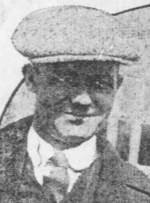 The Post-Crescent (Appleton, WI) - February 26, 1923 Sentenced to life in prison in 1922 for the murder of police officer Emery McCreight in Wilmington, Ohio, Clarence Leroy McKinney was exonerated as the result of another man’s confession almost one year later. Officer McCreight and his partner, Henry Adams, were patrolling the streets of Wilmington, Ohio, on the night of Valentine’s Day, February 14, 1922, checking the town’s dark alleys. Upon hearing noises emanating from the back of a hardware store, they approached for a closer look. Spotting two men, the officers asked them what they were doing. One replied, “looking for a dog.” Officer Adams flashed his light at the men who, it turned out, were attempting to cut their way through the rear door of the hardware store. The burglars opened fire on the two officers and escaped in a waiting car. McCreight died of his wounds the next day. Adams had also been shot, but he survived. The sheriff’s immediate investigation focused on Officer Adams’ description of the one burglar he had seen clearly, and his recollection that the burglar wore a particular type of coat and a toboggan hat. The sheriff and his deputies interviewed the known owners of such coats and hats, without success. A reward was offered, and a private investigator was engaged to assist the sheriff. About ten days after the shooting, a local farm hand, Charles Smalley, reported that very early on the morning following the murder, he had come upon two men, whom he knew as Clarence McKinney and Jim Bill Reno of Cincinnati, by the side of the road with a flat tire. (Cincinnati is about 45 miles southwest of Wilmington). They asked Smalley for a spare tire. They were carrying a large load of moonshine. They gave Smalley a drink of whiskey, and told him not to tell anyone that he had seen them on the road that day. The next morning, the local officers drove to Cincinnati and arrested McKinney for the murder of Officer McCreight. He was returned to the county jail in Wilmington, where two witnesses identified him as having been at a drugstore in that town the evening of the murder. Deputies then dressed McKinney in the type of coat and the toboggan hat previously described by Officer Adams as being worn by McCreight’s murderer. Officer Adams flashed his light in McKinney’s face, as he had to the burglar on the night of the shooting, and positively identified McKinney as the shooter. McKinney and Reno were then charged with first-degree murder and with illegally transporting liquor. The liquor charges were tried first, and both men were convicted. On August 22, 1922 - four months after the murder – McKinney’s homicide trial began. It lasted over a week. The state’s case focused on Officer Adams’ positive identification of McKinney, the testimony of the two witnesses who placed McKinney in Wilmington the evening of the murder, and Smalley’s statement that he had seen McKinney and Reno the next morning stalled on the road. Both men provided alibis as their defense, though McKinney’s seemed manufactured. Over fifteen witnesses from Cincinnati testified that on the night of the murder, McKinney and his new bride were at a movie theater, and that Reno was playing poker with friends. McKinney also testified, and was cross-examined with evidence of his prior convictions and other run-ins with the law. He and his witnesses created the impression that he and Reno were in the business of brokering dairy products in Cincinnati. However, the weight of the testimony suggested that they were really in the illicit liquor business. The jury convicted McKinney of first-degree murder, but recommended mercy. He was sentenced to life in prison. Several months later, some young men reported to the sheriff that they had heard another young man, Louis Vandervoort, brag that he had shot and killed McCreight. Although dubious, the sheriff had Vandervoort arrested. Vandervoort was 19 years old and fit Officer Adams’ original description of the murderer. Under questioning, Vandervoort confessed to the McCreight homicide, and to a rash of burglaries as well, even identifying where some of the loot from his burglaries could be found. Upon recovering the booty where Vandervoort had said it would be and further corroborating his story, the sheriff charged Vandervoort with McCreight’s murder. Vandervoort named his accomplice in the McCreight murder, 19-year old Walter Bingham, who also confessed. Vandervoort and Bingham pleaded guilty to seconddegree murder and manslaughter, respectively. Vandervoort was sentenced to life in prison; Bingham to a one-to-twenty year prison term. Since his appeal was then pending in the Ohio Court of Appeals, the appellate court ordered McKinney’s case returned to the trial court for a new trial. Two days later, on February 24, 1923, the prosecution dismissed the case, and McKinney was released. Judge F. M. Clevenger expressed his regret over the miscarriage of justice, but characterized the trial as a pure “case of mismanagement on the part of the defense.” Clevenger was apparently referring to McKinney's false alibi, which he had admitted to the court on the day of his release. More specifically, McKinney admitted that he had been in Wilmington on the night of the murder – and not in Cincinnati as he and his witnesses had testified – and that he had attempted to establish a false alibi not only to escape the murder charge, but also to avoid the liquor charges. McKinney was philosophical about what had happened. “Sure,” said McKinney upon his release, “we all have our troubles. I knew this would come out all right.” The fines in the liquor cases were suspended for both McKinney and Reno as a form of restitution. – Researched by Lori B. Armstrong
|